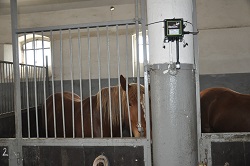Higher quality, more efficient farming through open standards
Over the course of the last two decades, farming in Europe has witnessed two simultaneous changes. On the one hand, increasing EU and national regulations, such as cow registries, has placed new administrative demands on farmers. At the same time, the sector has seen the deployment of a range of sophisticated technologies in the area of machinery and automation. To help European farmers better manage these administrative demands while taking full advantage of new technological opportunities, the EU-funded AGROIT project has implemented an innovative open platform based on open standards. ‘The premise of this project is our belief that the deployment of ICT is the next step forward that will change farming and enable the transition to higher quality and more efficient agricultural sector,’ says project coordinator Rok Rupnik. Apps and data The project’s objective was to build an open-standard based AGROIT platform to deliver applications and services to farmers, local communities, state and EU institutions and agriculture-related consultants. With these applications, farmers have the ability to simply and easily input data during the execution of their daily activities – even with dirty hands or in rough conditions. ‘Based on our existing prototypes, we implemented a scenario-oriented user interface to enable farmers to have a sequenced order of daily activities,’ explains Rupnik. ‘By using these applications, farmers can significantly increase the efficiency of their activities and save on resources – including time.’ In addition to the applications, the project also developed integrated monitoring systems that enable the collection of data from sensors and other devices via wireless technology. ‘Historically, farming has been opaque business because of the difficulty in obtaining solid datasets, making it irrational to expect a farmer to fill out forms after a day in the field,’ adds Rupnik. ‘But data collected from sensors and machines brings new possibilities for analyses and data-driven decision making.’ AGROIT integrated all of these features into a platform. ‘Here, standards and integration examples have been published under public domain or creative-commons licenses to allow collaboration and support within the agriculture industries and communities,’ explains Rupnik. Rupnik notes that several advantages of using an open platform. For instance, it allows users to integrate multiple systems in order to provide more robust and more easily accessible information. By facilitating collaboration between developers, open platforms also lead to better, more tailored solutions. Putting it into practice So what does this all look like in practice? As an example, let’s take the routine agricultural task of preparing a field for planting. Thanks to the use of GPS, AGROIT’s mobile app will know that the farmer is working in a particular field and thus can provide them with an overview of what areas have been cut and which areas still need tending to. Or let’s say a fruit farmer notices a problem with one of her plum trees. By opening a consultancy case via the mobile application, she simply snaps some photos of the tree and makes a phone call to a consultant to discuss a solution. After the call, the consultant checks the farmer’s operational data (e.g. field shapes, hybrids, past treatments, etc.) and inserts treatment specifics into the consultancy case for the farmer to implement in the field. The AGROIT app can even help veterinarians providing care to farm animals. ‘In many rural areas, veterinarians are few and far between,’ says Rupnik. ‘But now, thanks to the AGROIT app, a farmer can consult with a vet remotely and exchange documents or certificates electronically.’
Keywords
AGROIT, agriculture, open data, open standards, precision agriculture, cloud computing, farming

